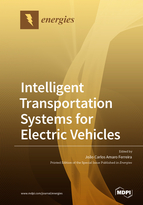Intelligent Transportation Systems for Electric Vehicles
A special issue of Energies (ISSN 1996-1073). This special issue belongs to the section "E: Electric Vehicles".
Deadline for manuscript submissions: closed (30 April 2020) | Viewed by 84552
Special Issue Editor
Interests: IoT; Big Data; Smart cities; ITS; Vehicle electric
Special Issues, Collections and Topics in MDPI journals
Special Issue Information
Dear Colleagues,
The Guest Editor is inviting submissions for a Special Issue of Energies on the subject area of “Intelligent Transportation Systems (ITS) for Electric Vehicles (EV)." The EV and Charging Station (CS) markets have been growing exponentially, and a forecast from the International Energy Agency estimates an increase of EV sales from the current 3 million to 125 million by 2030. This raises additional challenges in terms of the network required to fulfill the charging requirements of the EV. The CS market is growing by 40% a year and is currently worth $300 billion. Electromobility and ITS are essential components in decarbonizing road transportation and play an essential role in the mobility process of Smart Cities. ITS also play an essential task in this transformation, owing to the flexibility of the EV charging process and the EV operation, which operates as an energy storage device; it also helps to facilitate the market penetration of renewable energy resources. In parallel, IoT approaches allow the collection of large volumes of data and big data approaches, creating opportunities to develop solutions to overcome challenges such as the ones that emerge from the EV charging process, CS locations, and the reservation of charging spots.
This Special Issue will focus on emerging ITS for EV and applications for electromobility and Smart Grids. Topics of interest for publication include, but are not limited to, the following:
- Electric Vehicles and Intelligent Transportation Systems
- Infrastructure studies and solutions for the charging process (CS location, process, and others)
- Technological developments for EV operation in Smart Grids
- V2* (Vehicle to Anything) process and connection
- Intelligent Transportation Systems for EVs
- Energy supply, storage systems, charging station and process
- Smart Grids, renewable energy, demand-response
- Smart Mobility and Cities
- ITS and big data
- IoT for ITS and EV
- Case studies and the assessment of ITS applications and the EV charging process
- The standardization process
Keywords
- electromobility
- intelligent transportation system
- storage and charging station systems
- V2*—vehicle to anything or anything to vehicle
- smart cities and grids
- IoT and big data






